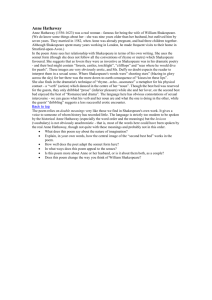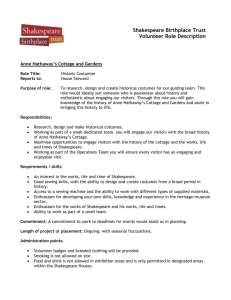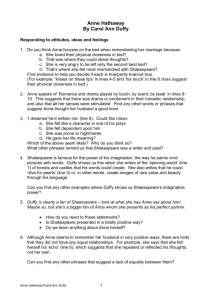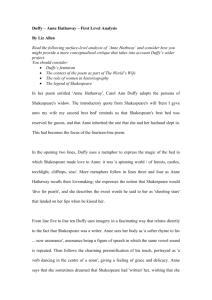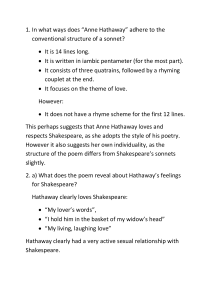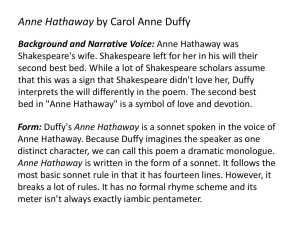Anne Hathaway - HigherUddyEnglish
advertisement
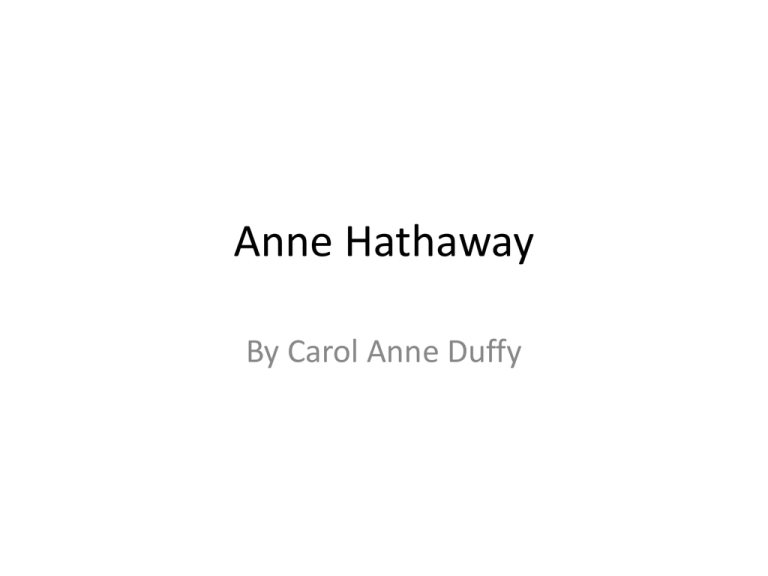
Anne Hathaway By Carol Anne Duffy Anne Hathaway – Historical Background • Anne Hathaway (1555/56 – 6 August 1623) was the wife of William Shakespeare – English poet, playwright and actor. • She was nine years older than her husband, who married her when she was pregnant with their first child. • They spent long periods of time apart; he went to London to work in the theatres whilst she stayed behind in Stratford upon Avon. • Hathaway outlived her husband by seven years. Duffy’s poem makes reference to a well known excerpt from Shakespeare’s will: “Item I gyve unto my wife my second best bed…” • Many scholars have seen this as confirmation that the couple had become estranged, and that this parting gift was meant to be a snub on Shakespeare’s part. • However, Duffy’s poem takes a different attitude, using the bed as a focus through which to explore the romantic and intimate moments the couple shared. This might be Anne Hathaway (but it probably isn’t). The Sonnet In many ways “Anne Hathaway” adopts the traditional poetic form known as the sonnet. A sonnet is a type of English poem which is clearly identified by the following characteristics: • It usually focuses on the theme of love; • It usually adheres to the following structure: – It is fourteen lines long; – These lines consist of 3 quatrains (groups of four lines) followed by a rhyming couplet (pair of lines that rhyme); – It has a regular rhyme scheme; Shakespeare favoured ABAB CDCD EFEF GG; – Each line is written in iambic pentameter. Beyond his plays, Shakespeare is perhaps best known for writing sonnets, having produced 154 of them in his lifetime. An Example: Shakespearean Sonnet 12 When I do count the clock that tells the time, And see the brave day sunk in hideous night; When I behold the violet past prime, And sable curls ensilvered o’er with white; When lofty trees I see barren of leaves, Which erst from heat did canopy the herd, And summer’s green all girded up in sheaves Borne on the bier with white and bristly beard: Then of thy beauty do I question make That thou among the wastes of time must go, Since sweets and beauties do themselves forsake, And die as fast as they see others grow; And nothing 'gainst time’s scythe can make defence Save breed to brave him when he takes thee hence. “Anne Hathaway” and the Sonnet Form 1. In what ways does “Anne Hathaway” adhere to the conventional structure of a sonnet? 2. a) What does the poem reveal about Hathaway’s feelings for Shakespeare? b) How is this made clear? 3. What do you not understand about the poem? “Anne Hathaway” – Annotation (1) The bed we loved in was a spinning world of forests, castles, torchlight, cliff-tops, seas where he would dive for pearls. My lover’s words were shooting stars which fell to earth as kisses on these lips; “Anne Hathaway” – Annotation (2) on these lips; my body now a softer rhyme to his, now echo, assonance; his touch a verb dancing in the centre of a noun. Some nights I dreamed he’d written me, the bed a page beneath his writer’s hands. “Anne Hathaway” – Annotation (3) a page beneath his writer’s hands. Romance and drama played by touch, by scent, by taste. In the other bed, the best, our guests dozed on, dribbling their prose. My living laughing love – “Anne Hathaway” – Annotation (4) I hold him in the casket of my widow’s head as he held me upon that next best bed.
